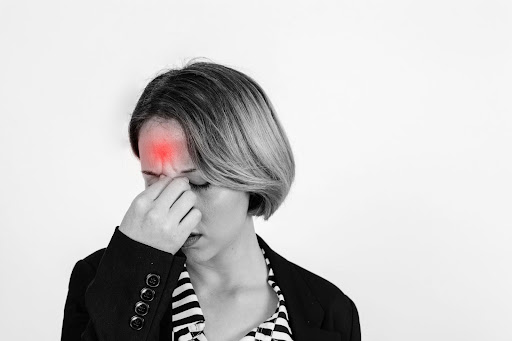Headaches are a common complaint in clinical practice, but not all headaches originate in the head itself. Some are classified as secondary headaches caused by underlying conditions elsewhere in the body. One such condition is the cervicogenic headache, a type of pain that originates in the cervical spine but presents primarily as head pain. In this article, we’ll explore cervicogenic headaches in detail, including symptoms, causes, diagnosis, and treatment options that work, especially with non-surgical approaches offered by pain specialists at Alleviate Pain Clinic.

What Is a Cervicogenic Headache?
A cervicogenic headache is a secondary headache that arises from dysfunction or pathology in the cervical spine (neck region). These headaches are typically unilateral, meaning they affect one side of the head, and are often accompanied by neck pain and stiffness. Unlike migraines or tension headaches, cervicogenic headaches are not caused by primary neurological issues but rather by musculoskeletal or structural problems in the neck.
Causes of Cervicogenic Headaches
The root causes of cervicogenic headaches lie in disorders of the cervical spine and surrounding soft tissues. These may include joint dysfunction, nerve compression, and muscular irritation.
Cervical Spine Disorders
Cervical spine disorders such as degenerative disc disease, cervical spondylosis, and facet joint arthropathy are major contributors to cervicogenic headaches. These conditions lead to mechanical instability and inflammation in the neck, which in turn irritate the upper cervical nerves connected to the head.

Neck Trauma and Injury
Past trauma, including whiplash injuries from road accidents or falls, can disrupt the normal biomechanics of the cervical spine. Even minor injuries may lead to chronic irritation of cervical joints and muscles, resulting in neck-related headaches. Repetitive strain from poor posture, especially due to prolonged computer or mobile use, is also a common contributing factor.

Symptoms of Cervicogenic Headaches
Understanding the symptoms of cervicogenic headache helps differentiate it from other types of headaches. These symptoms often overlap with neck pain and are usually consistent and reproducible.
Common Pain Patterns
Pain typically begins in the neck or back of the head and radiates forward to the fronto-temporal or orbital regions. It may be constant or fluctuate in intensity and is usually felt on one side of the head. Unlike migraines, cervicogenic headaches do not have aura, nausea, or photophobia as predominant features.
Triggers and Aggravating Factors
Neck movement, prolonged static posture, or pressure applied to the upper cervical spine often worsens the pain. Physical activity, especially involving head and neck movement, may aggravate symptoms. Patients often report relief after resting the neck or applying heat.
Diagnosing Cervicogenic Headaches
Correct diagnosis is essential for effective treatment. Because cervicogenic headaches mimic other headache types, clinical evaluation is crucial.
Clinical Assessment and Medical History
Diagnosis is based on a detailed medical history, physical examination, and exclusion of other headache types. Pain specialists assess neck mobility, tenderness in the upper cervical spine, and the presence of trigger points in cervical muscles. Imaging studies such as MRI or CT scans may be used to identify underlying cervical spine disorders.
In some cases, diagnostic blocks such as an occipital nerve block are used. If the headache subsides after the block, it confirms a cervical origin.
Diagnostic Imaging and Nerve Blocks
Imaging studies like MRI or CT scans may be employed to identify structural abnormalities in the cervical spine. Diagnostic nerve blocks, such as occipital nerve blocks, can help confirm the cervical origin of the headache by temporarily relieving pain.
Treatment Options That Work
At Alleviate Pain Clinic, a multidisciplinary approach is adopted for treating cervicogenic headaches, with a focus on non-surgical pain management. Treatments are personalised based on the severity of symptoms and underlying cause.
Conservative Treatments
Initial treatment includes rest, lifestyle modifications, and medications. Non-steroidal anti-inflammatory drugs (NSAIDS) and muscle relaxants help manage inflammation and pain. Physical therapy plays a key role in improving neck mobility, strengthening and stabilising muscles, and correcting posture. Techniques like myofascial release and trigger point therapy provide relief from muscular tightness, contributing to neck pain and headaches.
Interventional Pain Management
For patients not responding to conservative care, interventional treatments offer effective alternatives:
- Occipital nerve block: Injection of anaesthetic near the greater or lesser occipital nerves helps reduce inflammation and interrupt pain signals.
- Cervical facet joint injections: These target inflamed joints in the cervical spine, offering targeted relief.
- Radiofrequency ablation: A minimally invasive technique where heat is used to deactivate nerve fibres transmitting pain from cervical joints. This provides long-term relief in suitable patients.
These interventional methods are performed under imaging guidance to ensure precision and safety.
Preventive Strategies and Lifestyle Adjustments
Prevention is equally important in managing cervicogenic headaches. Regular neck exercises, ergonomic adjustments at the workplace, and avoidance of forward-head posture help maintain cervical spine health. Patients are advised to take breaks during screen time and use supportive pillows for sleep. Hydration, stress management, and posture correction are key components of long-term management.
When to See a Healthcare Professional
You should consult a pain specialist if you experience:
- Persistent, one-sided headaches accompanied by neck stiffness
- Worsening pain with neck movement
- Headaches are not relieved by over-the-counter medication.
- History of neck trauma or cervical spine disorders
- Recurrent headaches interfering with daily activities
Pain specialists at Alleviate Pain Clinic are experts in diagnosing and treating neck pain and headaches with non-surgical solutions, helping patients avoid unnecessary invasive procedures.
Conclusion
Cervicogenic headache is a debilitating condition stemming from cervical spine disorders, often misdiagnosed or overlooked. Recognising the symptoms of cervicogenic headache and seeking timely care from a pain specialist can significantly improve quality of life. With a structured diagnosis and a combination of conservative and interventional treatments, it is possible to manage neck-related headaches effectively without surgery.
At Alleviate Pain Clinic, our team of experts specialises in non-surgical treatments for chronic pain conditions like cervicogenic headache, back pain, shoulder pain, and knee pain. We are committed to providing evidence-based care tailored to each patient’s needs. If you’re experiencing persistent neck pain and headaches, schedule a consultation with our team to explore treatment options that work.
For more information, visit www.alleviatepainclinic.com.
FAQs
The most effective treatment combines physical therapy, posture correction, and interventional pain management such as occipital nerve blocks or radiofrequency ablation. These non-surgical approaches target the root cause in the cervical spine for long-term relief.
Diagnosis involves a clinical assessment, detailed medical history, and physical examination focusing on neck mobility and tenderness. Imaging studies and diagnostic nerve blocks may also be used to confirm the cervical origin of the headache.
Cervicogenic headaches are managed by treating the underlying neck issues. This includes physiotherapy, anti-inflammatory medications, nerve blocks, and lifestyle changes. Interventional procedures like radiofrequency ablation may be used for long-term relief in persistent cases.
MRI does not directly diagnose cervicogenic headaches, but helps identify underlying cervical spine disorders like disc degeneration, joint inflammation, or nerve compression, which contribute to these headaches. It supports clinical diagnosis and treatment planning.
You should consult a pain management specialist with expertise in spinal disorders. These specialists diagnose cervicogenic headaches and offer non-surgical treatments like nerve blocks and physiotherapy tailored to neck-related headache conditions.




